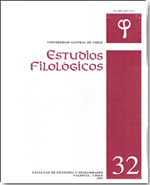A case of linguistic convergence in Santiago del Estero (Argentina). The development of the periphrastic future
Main Article Content
Abstract
This article examines the syntactic function of the construction verb of movement (generally riy 'to go') + verb base nominalized by the agentive suffix -q in the Quechua spoken in Santiago del Estero (Argentina) today. Whereas in all the other dialects of Quechua this structure is used to indicate actual physical movement on the part of the subject in order to carry out some sort of task, in Santiago Quechua it simply indicates a future action. A study of the formal, functional and sociolinguistic characteristics of this syntactic structure reveals that its origin is to be found in the transfer of the future meaning of the modern-day Spanish periphrasis ir a 'to go' + infinitive to this structure in Santiago Quechua (variety L located in an area of intensive diglossia).

